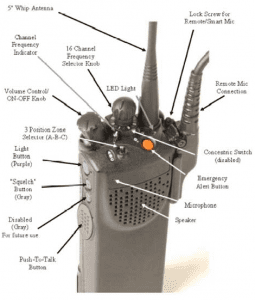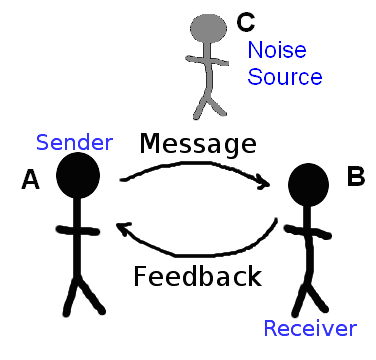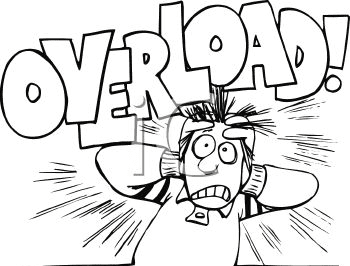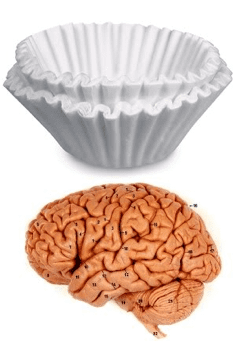 When it comes to first responder radio traffic I am reminded of the tale of Goldilocks and the Three Bears.
When it comes to first responder radio traffic I am reminded of the tale of Goldilocks and the Three Bears.
You may recall that in the story Goldilocks samples three bowls of porridge. One is too hot. One is too cold. And the third is just right.
This lesson applies directly to first responder situational awareness and the role radio communications plays in helping to develop and maintain SA. Let’s explore radio traffic.
Communications
 To start, let’s review what is required for communications to occur. There needs to be someone to transmit a message (the sender), a way for the message to be sent (the medium) and someone to receive the message (the receiver). While communications is most often verbal, it doesn’t have to be. Humans have the ability to engage in complex communications which means we can convey messages with symbols.
To start, let’s review what is required for communications to occur. There needs to be someone to transmit a message (the sender), a way for the message to be sent (the medium) and someone to receive the message (the receiver). While communications is most often verbal, it doesn’t have to be. Humans have the ability to engage in complex communications which means we can convey messages with symbols.
A flat open hand, face down, with the fingers pointing toward the throat, sweeping back and forth is one example of a non-verbal sign that may be interpreted as meaning “stop.” We can communicate in many ways: giving a certain look, images, signs, words, sounds (like a grunt), music, colors, symbols, etc. Here we are focusing in radio communications.
Visual Imaging
 When you hear descriptive information shared over the radio, your ears process the sound waves into electrical impulses that are sent off to the auditory processors of the brain. You have two of them, one behind each ear. However, for comprehension to occur – which is different than hearing – the verbal message is sent over to the visual processor of the brain to be sketched into am image. Stated simply, your thoughts are drawn into visual images using your visuospatial sketchpad.
When you hear descriptive information shared over the radio, your ears process the sound waves into electrical impulses that are sent off to the auditory processors of the brain. You have two of them, one behind each ear. However, for comprehension to occur – which is different than hearing – the verbal message is sent over to the visual processor of the brain to be sketched into am image. Stated simply, your thoughts are drawn into visual images using your visuospatial sketchpad.
This concept was first revealed by psychologist Alan Baddeley as he sought to explain the role of imagery in short term memory capacities. Once sketched, one of two things can happen to the message. The information can be retained (transitioned into long-term memory) or it can be erased (forgotten). There are a variety of factors that help determine which will happen, including repetition of the message (or repetition of thought of the message) and the degree to which the message elicits an emotional response.
Sparing you all the details, simply know that audible messages are sketched into visual images and it is those very images that help form, and maintain, situational awareness. If the images are sharp, and accurate, we are said to have good situational awareness. If the images are unclear or inaccurate, we are assumed to have flawed situational awareness.
A Busy Place
 The visual processor of the brain is a busy place during an emergency incident because it’s doing double duty. [tweet this] It’s processing everything you see into visual images AND it’s processing everything you hear into visual images.
The visual processor of the brain is a busy place during an emergency incident because it’s doing double duty. [tweet this] It’s processing everything you see into visual images AND it’s processing everything you hear into visual images.
This can be both an asset and a liability and the outcome depends on the quantity and quality of the visual and auditory inputs. As it relates to auditory messages, the more clear the message, the easier it is for the brain to sketch – no guessing. The corollary being: The less clear the message, the harder it will be for the brain to sketch an accurate image.
Overload
 While the visual processor has a tremendous capacity to capture and comprehend (i.e., sketch) visual and audible information, it can be overloaded. And when it becomes overloaded some very undesirable things can happen.
While the visual processor has a tremendous capacity to capture and comprehend (i.e., sketch) visual and audible information, it can be overloaded. And when it becomes overloaded some very undesirable things can happen.
The visual processor can begin filtering out messages and, quite literally, it can shut down completely. If it shuts down vision, it’s called stress-induced blindness. If it shuts down hearing it’s called auditory exclusion.
No Filters
 The brain has no way to filter important auditory messages from non-important auditory messages. [tweet this] To comprehend the meaning requires completing the intake and processing of the message. Only after the image has been sketched into meaning can the brain determine if it was an important message or not. It takes the brain the same amount of effort to distinguish an important message from a non-important message.
The brain has no way to filter important auditory messages from non-important auditory messages. [tweet this] To comprehend the meaning requires completing the intake and processing of the message. Only after the image has been sketched into meaning can the brain determine if it was an important message or not. It takes the brain the same amount of effort to distinguish an important message from a non-important message.
When there is a lot of radio traffic, the brain has to process and comprehend every message. If there are a lot of unimportant messages being shared on the radio, the audible and visual processors can quickly become overloaded. When insufficient information is shared by radio, the brain cannot sketch an accurate image of what is happening.
Chief Gasaway’s Advice
 The key for radio traffic is to practice the Goldilocks rule: Not too much, not too little, just right. [tweet this] But how do you know if your radio traffic is too much, too little or just right? One way is to listen to tapes of radio traffic from incidents. Sometimes it’s not readily apparent how much (or how little) radio traffic there was until you listen to the audio tapes. Would a person who was not on the call be able to understand what was happening on the scene based on the radio traffic?
The key for radio traffic is to practice the Goldilocks rule: Not too much, not too little, just right. [tweet this] But how do you know if your radio traffic is too much, too little or just right? One way is to listen to tapes of radio traffic from incidents. Sometimes it’s not readily apparent how much (or how little) radio traffic there was until you listen to the audio tapes. Would a person who was not on the call be able to understand what was happening on the scene based on the radio traffic?
Another way to evaluate the quality of communications is to ask the responders who were on the scene if they understood what was happening. It can also be enlightening to have responders listen to the tape of the radio traffic and ask them how much of the radio traffic they did not hear. One of the consequences of too much radio traffic is we can stop listening. When there’s too much radio traffic, the messages can turn into noise and be tuned out by the receiver. This can inflict any responder on the scene from front line responders to the incident commander.
Action Items
 1. Evaluate both the quantity and quality of radio communications. Ensure that only essential messages are transmitted by radio and the sender of the message is using terms that are easy to process and comprehend.
1. Evaluate both the quantity and quality of radio communications. Ensure that only essential messages are transmitted by radio and the sender of the message is using terms that are easy to process and comprehend.
2. Discuss what radio traffic is critical to share and what traffic is unnecessary. Determine if a component of the operation could be taken to a separate channel or talk group without impacting incident scene safety (e.g., water shuttle operations).
3. Discuss how to incorporate training on radio communications into department drills. Radio communications is far too important to assume responders will know what to say, how to say it, and when they don’t need to say it at all.
___________________________________________________________
The mission of Situational Awareness Matters is simple: Help first responders see the bad things coming… in time to change the outcome.
Safety begins with SA!
___________________________________________________________
Share your comments on this article in the “Leave a Reply” box below. If you want to send me incident pictures, videos or have an idea you’d like me to research and write about, contact me. I really enjoy getting feedback and supportive messages from fellow first responders. It gives me the energy to work harder for you.
Thanks,
Email: Support@RichGasaway.com
Phone: 612-548-4424
Facebook Fan Page: www.facebook.com/SAMatters
Twitter: @SAMatters
LinkedIn: Rich Gasaway
YouTube: SAMattersTV
iTunes: SAMatters Radio


Great Post! Thank you for sharing usefull information. We are also provider of Traffic Message Signs. Visit our website for more info highway1.co.nz